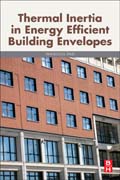
Thermal Inertia in Energy Efficient Envelopes provides the tools and methods for designing the energy efficient envelopes that will reduce energy consumption and achieve building heating and cooling efficiency. The book presents both numerical and experimental methods for quantifying energy consumptions, while also considering their interaction with dynamic strategies, such as thermal inertia and natural ventilation. Each type of envelope and optimal solutions are drawn at the varying climates (mild or extreme), building typology (skin dominated or core dominated buildings), and mode of use of the internal environment (heating profiles and cross-ventilation). Provides a comprehensive review of resilience theories and practices in key fields of studyPresents a detailed study of the structural resilience approach to sewer reconstruction in Tokyo, also including case studies of overseas projectsIncludes a systematic presentation of structural resilience theoriesCovers rich case studies on various issues in sewerage systems for qualitative and quantitative resilience evaluation INDICE: 1. High thermal resistance versus high thermal capacity: The dilemma2. The envelope: A complex and dynamic problem3. Retrofit of existing envelopes4. New envelopes5. Passive envelopes6. Methods: Experimental surveys, analytic explorations and model reliability
- ISBN: 978-0-12-813970-7
- Editorial: Butterworth-Heinemann
- Encuadernacion: Rústica
- Páginas: 382
- Fecha Publicación: 16/08/2017
- Nº Volúmenes: 1
- Idioma: Inglés
